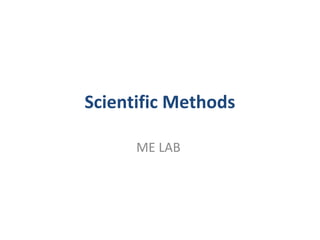
Scientific methods
- 1. Scientific Methods ME LAB
- 2. Scientific Methods • The only way accepted to back up a theory or idea. • The method in which all research project should be based. • The method used by researchers to support or disprove a theory. • Involves series of steps that are used to investigate natural occurrences.
- 3. Scientific Method Data contradict the hypothesis Adjust hypothesis or theory Make an Form an Collect Data observation hypothesis Perform the relevant data supports that explains experiment the The by repeated observations trials hypothesis hypothesis is now a theory
- 4. Step 1: OBSERVATION You observed something using your senses. What do you see that makes you a ask a question or state a problem. Develop a question or problem that can be solved through experimentation. This is also known as “Test Table Questions.”
- 5. Examples of a Test Table Question • Does the air velocity increase as the diameter of the duct increases? • Does the pressure increases when the fluid velocity increases? • Does the lubricant viscosity change at different temperatures? • Does the lubricant ignite at a certain temperature?
- 6. Step 2: FORM A HYPOTHESIS A hypothesis is an “educated guess” about the outcome of your experiment. You predict what you think the answer to your question might be. In order to make this guess, you must rely on your background knowledge and the research which you conducted before the experiment.
- 7. A Well Written Hypothesis A well written hypothesis consists of an “IF” statement and a “THEN” statement. The “IF” statement contains information on what you are testing, and the “THEN” statement reflects your belief of the outcome of the experiment. EXAMPLE: “IF we increase the diameter of the duct, THEN the air velocity will decrease.”
- 8. Step 3: PERFORM EXPERIMENT You figure out a way to test whether the hypothesis is correct. The outcome must be measurable. Record and analyze data.
- 9. Writing a Procedure A procedure is a list of steps that a scientist/researcher takes to complete the experiment. This is a very detailed list that is numbered in 1, 2, 3,… order. It is not a paragraph. Include a detailed material list. It may include actual pictures or drawings of equipment set-up. You know you have written a good procedure when someone can read it and do the experiment exactly like you did. Be sure to follow all the general safety procedures while conducting the experiment.
- 10. Gathering Materials In order to perform an experiment, you must make a list of the equipment you will use. This list is written above your procedure. It allows other people to do your experiment without having to ask you what they need.
- 11. Example of Well Written Procedure 1. Number each battery so you differentiate each other. 2. Measure each battery's voltage by using the voltmeter. 3. Put the same battery into one of the devices and turn it on. 4. Let the device run for thirty minutes before measuring its voltage again. (Record the voltage in a table every time it is measured.) 5. Repeat #4 until the battery is at 0.9 volts or until the device stops. 6. Do steps 1–5 again, three trials for each brand of battery in each experimental group. 7. For the camera flash push the flash button every 30 seconds and measure the voltage every 5 minutes. 8. For the flashlights rotate each battery brand so each one has a turn in each flashlight. 9. For the CD player repeat the same song at the same volume throughout the tests.
- 12. Step 4: COLLECTING AND ANALYZE RESULTS Modify procedure if needed. Confirm the results by retesting. Include tables, graphs, and photographs.
- 13. Recording Data All measurements in an experiment need to be recorded in a data table. The table must have a title (related to what you are measuring) and appropriate labels for the rows and columns. All variables used in the experiment must be carefully defined. Appropriate units should be included in the data collected.
- 14. Example of Data Table
- 15. Graphing Your Data Table In order to understand and interpret your data, you need to make a graph. A graph will help you see trends in the data and it will also assist you to look at the data in an easy way to understand. Remember to include labels in your graph.
- 16. Example of Data Graph
- 17. Step 5: DRAWING CONCLUSIONS The final piece of scientific method is drawing conclusions. In this step we analyze our data and graphs and decide if our hypothesis was correct or incorrect. We always restate our hypothesis in our conclusion. We discuss any trends we see and we attempt to explain why our hypothesis was correct or incorrect. You state whether your predictions was confirmed or not and try to explain your results. This is always in paragraph form. Make recommendations for further study and possible improvements to the procedure.
- 18. Step 6: COMMUNICATE THE RESULTS To make the experiment complete, we must share our findings with other people. Be prepared to present your experiment paper to an audience. Expect questions from the audience.